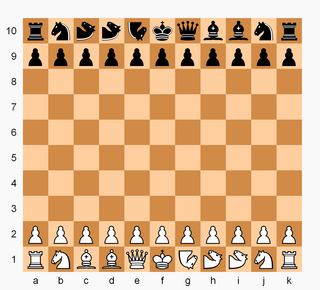Capablanca chess is a chess variant invented in the 1920s by World Chess Champion José Raúl Capablanca. It incorporates two new pieces and is played on a 10×8 board. Capablanca believed that chess would be played out in a few decades. This threat of "draw death" for chess was his main motivation for creating a more complex version of the game.
Grand Chess is a large-board chess variant invented by Dutch games designer Christian Freeling in 1984. It is played on a 10×10 board, with each side having two additional pawns and two new pieces: the marshal and the cardinal.
A fairy chess piece, variant chess piece, unorthodox chess piece, or heterodox chess piece is a chess piece not used in conventional chess but incorporated into certain chess variants and some chess problems. Compared to conventional pieces, fairy pieces vary mostly in the way they move, but they may also follow special rules for capturing, promotions, etc. Because of the distributed and uncoordinated nature of unorthodox chess development, the same piece can have different names, and different pieces can have the same name in various contexts. Most are symbolised as inverted or rotated icons of the standard pieces in diagrams, and the meanings of these "wildcards" must be defined in each context separately. Pieces invented for use in chess variants rather than problems sometimes instead have special icons designed for them, but with some exceptions, many of these are not used beyond the individual games for which they were invented.

The empress is a fairy chess piece that can move like a rook or a knight. It cannot jump over other pieces when moving as a rook but may do so when moving as a knight. The piece has acquired many names and is frequently called chancellor or marshal; it may also simply be called the rook+knight compound.

The princess is a fairy chess piece that can move like a bishop or a knight. It cannot jump over other pieces when moving as a bishop but may do so when moving as a knight. The piece has acquired many names and is frequently called archbishop or cardinal; it may also simply be called the bishop+knight compound.
Chess with different armies is a chess variant invented by Ralph Betza in 1979. Two sides use different sets of fairy pieces. There are several armies of equal strength to choose from, including the standard FIDE army. In all armies, kings and pawns are the same as in FIDE chess, but the four other pieces are different.

Minichess is a family of chess variants played with regular chess pieces and standard rules, but on a smaller board. The motivation for these variants is to make the game simpler and shorter than standard chess. The first chess-like game implemented on a computer was the 6×6 chess variant Los Alamos chess. The low memory capacity of early computers meant that a reduced board size and a smaller number of pieces were required for the game to be implementable on a computer.
Modern chess is a chess variant played on a 9×9 board. The game was invented by Gabriel Vicente Maura in 1968. Besides the usual set of chess pieces, each player has a prime minister and an additional pawn:
Philip M. Cohen is the inventor of several chess variants. He authored the column "Olla Podrida" in the periodical Nost-algia published by the correspondence game club NOST. The column regularly featured chess variants, many experimental, since 1972.

Wildebeest chess is a chess variant created by R. Wayne Schmittberger in 1987. The Wildebeest board is 11×10 squares. Besides the standard chess pieces, each side has two camels and one "wildebeest" - a piece which may move as either a camel or a knight.

Chad is a chess variant for two players created by Christian Freeling in 1979. It is played on an uncheckered 12×12 gameboard with one king and eight rooks per side, where rooks are able to promote to queens.

Dragonfly is a chess variant invented by Christian Freeling in 1983. There are no queens, and a captured bishop, knight, or rook becomes the property of the capturer, who may play it as his own on a turn to any open square. The board is 7×7 squares, or alternatively a 61-cell hexagon with two additional pawns per side.

The amazon, also known as the queen+knight compound, is a fairy chess piece that can move like a queen or a knight. It may thus be considered the sum of all orthodox chess pieces other than the king and the pawn. The amazon can force checkmate on an enemy king without the help of any other friendly piece.

Chesquerque is a chess variant invented by George R. Dekle Sr. in 1986. The game is played on a board composed of four Alquerque boards combined into a square. Like Alquerque, pieces are positioned on points of intersection and make their moves along marked lines ; as such, the board comprises a 9×9 grid with 81 positions (points) that pieces can move to.

Tri-chess is the name of a chess variant for three players invented by George R. Dekle Sr. in 1986. The game is played on a board comprising 150 triangular cells. The standard chess pieces are present, minus the queens, and plus the chancellor and cardinal compound fairy pieces per side.

Quatrochess is a chess variant for four players invented by George R. Dekle Sr. in 1986. It is played on a square 14×14 board that excludes the four central squares. Each player controls a standard set of sixteen chess pieces, and additionally nine fairy pieces. The game can be played in partnership or all-versus-all.
Tutti-frutti chess is a chess variant invented by Ralph Betza and Philip Cohen in 1978. It has been played regularly in tournaments and correspondence games, such as those of the Italian Association of Chess Variants.

Falcon–hunter chess is a chess variant invented by Karl Schultz in 1943, employing the two fairy chess pieces falcon and hunter. The game takes several forms, including variations hunter chess and decimal falcon–hunter chess added in the 1950s.
Chess on a really big board is a large chess variant invented by Ralph Betza around 1996. It is played on a 16×16 chessboard with 16 pieces and 16 pawns per player. Since such a board can be constructed by pushing together four standard 8×8 boards, Betza also gave this variant the alternative names of four-board chess or chess on four boards.












